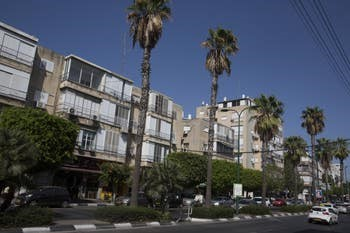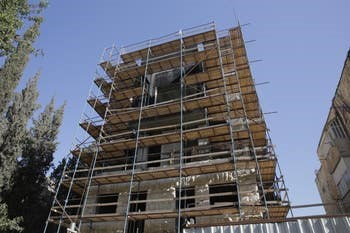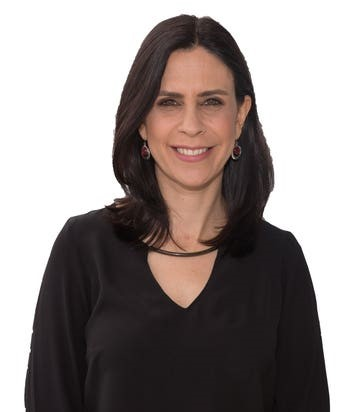The Marker, Adi Cohen, 07.03.2021
The National Master Plan for the Strengthening of Buildings, TAMA 38, is nearing the end of October 2022 without any clear alternative, but the struggles around it continue: Municipalities insist on charging an improvement levy for these projects - despite the exemption granted to them by law. Recently to the point of decisions, which appear to be a victory for developers and property owners - which may save millions of shekels in the payment of the improvement levy in each TAMA 38 project.
The first decision given the ongoing assessor contested the method of calculation of the rights conferred by virtue of NOP projects 38/1 (strengthening) in Tel Aviv, the lots where there is a partial penthouse floor. Until now, such structures calculated municipality the additional rights under the NOP improvement tax exempt (2.5 floors) When the partial roof floor was counted as an entire floor - and not as half a floor.
In other words, above this roof floor, developers could build, in accordance with the rights basket of NOP 38 , only another 1.5 floors exempt from the improvement levy - thus losing the amount exempt from the levy on half a roof floor.
"The change in Tel Aviv is relevant to hundreds of buildings. Especially in the 3rd district, between Ibn Gvirol and the sea, including Habima - where it is possible to renew almost only in a strengthening route."
Appraiser Danny Trashansky
However, in a decision given by the final appraiser Mordechai Dadon last week - in a case that discussed two buildings on Ben Yehuda Street in Tel Aviv - it was determined that the completion of the roof floor will not be considered as an entire floor, but only a partial floor. This means the addition of a half-floor incentive, which will now be exempt from the improvement levy, in hundreds of plots in central Tel Aviv. It is estimated that the value of this incentive is millions of shekels per building.
One decision, two buildings: by how much the improvement levy will be reduced in the TAMA 38 projects in Tel Aviv
Ben Yehuda 124
Before the NOP: 4-story residential building and partial roof
After the NOP: 6-story residential building
Improvement levy for the municipal system: NIS 600,000 The
levy after the decision: NIS 140,000
Reduction rate: 77%
Ben Yehuda 244
Before NOP: 3-story residential building and partial roof
After NOP: 6-story residential building
Improvement levy according to the municipality:NIS 4.15 million The
levy after the decision: NIS 2.5 million
Reduction rate: 40%
This decision also embodies a significant precedent in comparing the calculation of building rights granted in TAMA 38/1 projects (reinforcement) compared to TAMA 38/2 (demolition and construction). To date, the demolition and construction route has taken into account the full building rights that are exempt from improvement according to 2.5 floors - while in strengthening projects the tax-exempt addition was granted in accordance with existing construction. Dadon's decision was based on a ruling by the Haifa District Court in 2019.
Up to NIS 2.5 million for a building in Tel Aviv
In both buildings in Tel Aviv, the developers and tenants sought to close partial roof floors in order to maximize the addition of permitted floors in the NOP. NIS 1.2 million and NIS 8.3 million.
Following the decision of the final appraiser, the improvement payments were reduced to NIS 279,000 and NIS 5 million, respectively - a reduction of 77% and 40%. Since the levy is 50% of the improvement, the payments will be reduced by NIS 140,000 and NIS 2.5 million.
"This decision strengthens the economic viability of entrepreneurs in the TAMA reinforcement, and significantly reduces the differences in compensation for entrepreneurs between the two types of TAMA," says appraiser Danny Treshansky, from the Kamil-Treshansky-Rafael firm. "It provides another significant incentive to strengthen old buildings, which is reflected in an additional half floor that is exempt from the improvement levy."
According to Trashansky, "the decision may affect hundreds of buildings in Tel Aviv, especially in the 3rd district - between Ibn Gvirol Street and the sea, including the Habima area - where most of the buildings can only be renewed in the reinforcement route. "The shekel is an improvement levy. This has the potential to change the map of strengthening the buildings in the city."

Danny Trashansky Photo: No credit
TAMA before TBA - now also in Givatayim
The eastern neighbor, Givatayim, also ended a lengthy legal dispute last week over the calculation of improvement levies on TAMA projects in a grim defeat to the municipality - which folded from its stubborn struggle, which reached the Supreme Court. Calculation of existing building rights in TAMA 38 projects in the city.

Katznelson Street in Givatayim. Additional authorities are implementing the Givatayim Municipality's improvement calculation, and will now have to change it Photo: Tomer Applebaum
Until now, the Givatayim municipality has used to circumvent the statutory exemption for improvement levies on these projects. Changing the calculation method is good news for many property owners in the city and other authorities, who may benefit from a reduction of hundreds of thousands of shekels in the payment of improvements in urban renewal projects.
The legal dispute between the Givatayim Municipality and the tenants and developers of the TMA arose following an application for a permit submitted to the municipality by Eco City S.L. Entrepreneurship and Construction, for a demolition and construction project it is promoting on Kiryat Yosef Street in the city. And build in its place a six-story building with 28 apartments.
In the area of the plot, building rights both by virtue of NOP 38 and by virtue of another municipal plan. The payment claims that this calculation led to an increase in the area charged for the improvement levy by about 200 square meters - which increased the demand for payment by hundreds of thousands of shekels.

TAMA 38 project Photo: Olivia Fitoussi
In a decision on an appeal filed by the developer in the Tel Aviv District Court about a year and a half ago, the judge, Eliyahu Bachar, ruled that when calculating the improvement levy on plots with rights under both TAMA 38 and other municipal plans, all tax-exempt TAMA rights must be exhausted. , And only after that to charge an improvement on the remaining rights. This ruling puts an end to the method used by the municipality to this day, which is also applied by other authorities, which first calculates the rights of the landowners - which increases the payment of the improvement levy for hundreds of thousands of shekels per project.
The Givatayim municipality sought to appeal the district's decision, and appealed to the Supreme Court. The appeals committee dismissed the appeal, and the Supreme Court recommended the municipality withdraw the appeal and accept the district's decision. In other words, in demolition and construction projects, the exemption from the improvement levy applies to all the rights granted by the NOP - even if there is another plan of the authority that applies to the project.
"Uncertainty will worsen in light of the end of the NOP"
"Throughout the legal proceedings on the issue, the Givatayim Local Committee continued to charge developers improvement levies according to its method, despite the decisions of the Appeals Committee and the District Court," said Advocate Meital Twister Rosenthal of Ofer Toister, who represented Eco City. Of the Appeals Committee, and their treatment was frozen pending the decision of the Supreme Court. Now, the local committee will have to amend the levy requirements it has issued. "

Advocate Meital Twister Rosenthal Photo: Oren Golan
Eili Bar, co-CEO of Echo City, says that this is an important victory, but not the end of the controversy over the improvement levies: Millions of shekels, spent by local committees. In my opinion, the uncertainty in project pricing will worsen in light of the expected completion of the NOP in about a year and a half - which puts almost all projects currently being promoted by entrepreneurs at risk. "
The Givatayim Municipality responded: "The municipality's charges for improvement levies were initially imposed only in cases of demolition and reconstruction, in which the developers benefited from considerable improvement, while utilizing unused old rights - and also TAMA 38 rights. Thus contributing to all its residents suffering from a significant shortage of public spaces and open spaces.
"The Supreme Court was impressed by the sincerity and importance of the local committee's claims, but considered that an interpretation should be taken to reduce the liability for the levy and recommended that the local committee withdraw from the billing notices. ".
The Tel Aviv Municipality stated: "The decisions of the final appraiser, Moti Dadon, were made by the municipality about a week ago. The local committee will examine the determination of the final appraiser, and will act in accordance with the provisions of the law."



